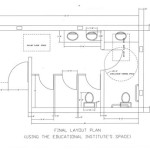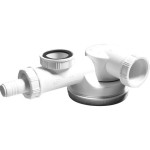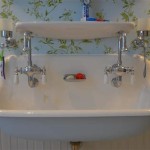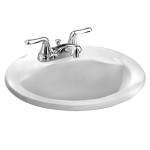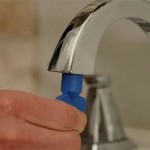DIY Bathroom Sink Drain Repair: A Comprehensive Guide
A leaking bathroom sink drain can be more than just an annoyance; it can lead to water damage, mold growth, and wasted water. While calling a plumber is always an option, many common drain issues can be resolved with a do-it-yourself (DIY) approach, especially when utilizing a bathroom sink drain repair kit. This article details the components of a typical repair kit, outlines common drain problems, and provides a step-by-step guide to effectively using a DIY bathroom sink drain repair kit.
Understanding the Components of a Bathroom Sink Drain Repair Kit
Bathroom sink drain repair kits are designed to address various issues stemming from leaky or damaged drain components. Before starting any repair, it's crucial to understand the purpose of each part within the kit. While the exact contents may vary depending on the manufacturer and the specific type of kit, some common components are consistently included:
*P-Trap:
The P-trap is a curved pipe designed to hold water, preventing sewer gases from entering the bathroom. It is typically made of PVC plastic or metal. A repair kit may include a replacement P-trap or individual components like the inlet arm, outlet arm, and the trap itself. *Tailpiece:
The tailpiece is the straight pipe that connects the sink drain to the P-trap. Repair kits might offer tailpieces of varying lengths or with adjustable features to accommodate different sink configurations. *Drain Flange:
The drain flange is the part that sits flush against the sink basin and connects to the tailpiece. It often includes a strainer to catch debris. Repair kits may include a new drain flange made of metal or plastic. *Washers and Gaskets:
These rubber or plastic rings are used to create watertight seals between different drain components. A variety of sizes and shapes are typically included to accommodate various connection points. *Slip Nuts:
These are threaded nuts used to tighten and secure the drain pipes together. They allow for easy assembly and disassembly of the drain system. *Plumber's Putty:
This pliable clay-like substance is used to create a watertight seal between the drain flange and the sink basin. *Thread Seal Tape (Teflon Tape):
This tape is used to wrap threaded connections to prevent leaks. *Optional Tools:
Some kits may include basic tools like a pipe wrench, adjustable wrench, or a screwdriver, although it's generally recommended to have a separate set of quality tools available.Identifying these components beforehand will streamline the repair process and ensure the correct parts are used for each step. It is also crucial to familiarize oneself with the specific instructions provided with the chosen repair kit, as variations in design and installation requirements may exist.
Common Bathroom Sink Drain Problems and Their Solutions
Before embarking on a repair, it's vital to diagnose the source of the leak or malfunction. Common bathroom sink drain problems include:
*Leaking P-Trap:
Cracks, loose connections, or corroded fittings can cause the P-trap to leak. Examine the P-trap for visible damage and tighten any loose slip nuts. If the P-trap is damaged, it will need to be replaced. *Leaking Tailpiece:
Similar to the P-trap, the tailpiece can develop cracks or loose connections. Inspect the tailpiece and tighten any slip nuts. If the tailpiece is damaged, it should be replaced. *Leaking Drain Flange:
A worn-out or improperly sealed drain flange can leak around the sink basin. Remove the old drain flange, clean the area thoroughly, apply fresh plumber's putty, and install a new drain flange. *Clogged Drain:
A clogged drain can cause water to back up in the sink. Remove the P-trap and clean out any debris. Use a drain snake to clear any blockages further down the drainpipe. *Corroded Pipes:
Over time, metal drain pipes can corrode, leading to leaks and structural weakness. Corroded pipes should be replaced with new PVC or metal pipes. *Improperly Tightened Connections:
Loose slip nuts can cause leaks at any joint in the drain system. Ensure all slip nuts are tightened securely, but avoid over-tightening, as this can damage the plastic components.A thorough inspection of the drain system is key to accurately identifying the problem and selecting the appropriate repair strategy. Sometimes, simply tightening a loose connection or cleaning out debris can resolve the issue. In other cases, replacing damaged components is necessary.
Step-by-Step Guide to Using a DIY Bathroom Sink Drain Repair Kit
Once the problem has been identified and the necessary repair kit has been selected, follow these steps to effectively repair the bathroom sink drain:
Step 1: Preparation
Turn off the water supply to the sink. This is typically done by closing the shut-off valves located under the sink. Place a bucket or basin under the drain to catch any water that may spill during the repair. Gather all necessary tools and materials, including the repair kit, pipe wrench, adjustable wrench, screwdriver, plumber's putty, thread seal tape, and cleaning supplies.
Step 2: Disassembly of the Old Drain
Carefully loosen and remove the slip nuts connecting the P-trap to the tailpiece and the drainpipe. Remove the P-trap and empty any water into the bucket. Loosen the slip nut connecting the tailpiece to the drain flange. If the drain flange is connected to the sink basin with a nut from underneath, loosen and remove that nut as well. Remove the old drain flange from the sink basin. Clean the area around the drain opening thoroughly, removing any old plumber's putty or debris. If the old components are corroded or difficult to remove, use a penetrating oil to loosen the connections.
Step 3: Installing the New Drain Flange
Roll a rope of plumber's putty and press it evenly around the underside of the new drain flange rim. Insert the drain flange into the drain opening from above. From underneath the sink, attach the rubber washer, cardboard washer, and tightening nut to the drain flange tailpiece. Tighten the nut securely, but avoid over-tightening. Remove any excess plumber's putty from around the edge of the drain flange.
Step 4: Assembling the Tailpiece and P-Trap
Attach the tailpiece to the drain flange. Secure the connection with a slip nut and washer. Place the P-trap under the tailpiece and connect it to the tailpiece and the drainpipe using slip nuts and washers. Ensure the P-trap is oriented correctly to hold water. Apply thread seal tape to the threaded connections of the drainpipe before connecting the P-trap.
Step 5: Tightening and Testing for Leaks
Tighten all slip nuts securely, but avoid over-tightening. Turn on the water supply to the sink slowly. Check for leaks at all connections. If any leaks are detected, tighten the corresponding slip nut further. If the leak persists, disassemble the connection, inspect the components, and reassemble with fresh washers or thread seal tape. For any threaded connections other than the slip joints, ensure thread seal tape or a pipe dope is used to create a proper water-tight seal.
Step 6: Final Inspection and Cleanup
After ensuring there are no leaks, run water in the sink for several minutes to verify the drain is functioning properly. Clean up any spills or debris from the work area. Discard the old drain components properly.
This step-by-step guide provides a general outline for repairing a bathroom sink drain. However, specific instructions may vary depending on the type of repair kit and the existing drain system. Always consult the manufacturer’s instructions for the specific repair kit being used. If unsure about any step, consult with a qualified plumber.
Essential Tools and Materials Beyond the Repair Kit
While a bathroom sink drain repair kit provides the necessary replacement parts, certain tools and materials not included in the kit are essential for a successful repair.
*Pipe Wrench and Adjustable Wrench:
These wrenches are crucial for loosening and tightening slip nuts and other fittings. Having a variety of sizes allows for working on different components. *Screwdriver (Various Types):
Depending on the drain flange design, a screwdriver may be needed to remove and install screws securing the flange to the sink. *Bucket or Basin:
A bucket is essential for catching water that will inevitably spill during disassembly. *Plumber's Putty Knife (Optional):
This tool can help to neatly remove excess plumber's putty after installing the drain flange. *Penetrating Oil:
This can be used to loosen corroded or stuck connections, making disassembly easier. *Drain Snake (Auger):
If the drain is clogged, a drain snake is necessary to clear the blockage. *Cleaning Supplies:
Rags, paper towels, and cleaning solutions are needed to clean the work area and the drain components. *Gloves:
Wearing gloves protects hands from dirt, grime, and potentially harmful chemicals. *Safety Glasses:
Safety glasses protect eyes from debris and splashes during the repair process.Having these tools and materials readily available will streamline the repair process and ensure a professional-looking result. Investing in quality tools will also make future plumbing repairs easier and more efficient.
How To Install Bathroom Sink Drain Queen Bee Of Honey Dos

How To Install A Bathroom Sink Drain Repair And Replace

How To Replace A Bathroom Sink Drain

How To Replace A Rusty Sink Drain Howtolou Com

How To Replace A Sink Stopper Quick And Simple Home Repair

How To Fix Bathroom Sink Drain Leaks Underneath Gasket Threads Solved
How To Install Bathroom Sink Drain Queen Bee Of Honey Dos

Bathroom Sink Drain Stopper Not Working

Plumbing How To Replace Sink Drain Stopper Home Improvement Stack Exchange

Fixing Tricky Pop Up Drain Sink Stopper Mechanisms Efficient Plumber
Related Posts

